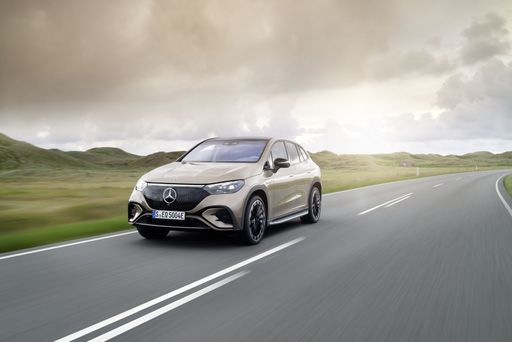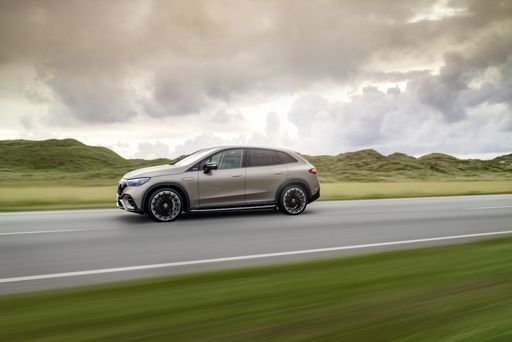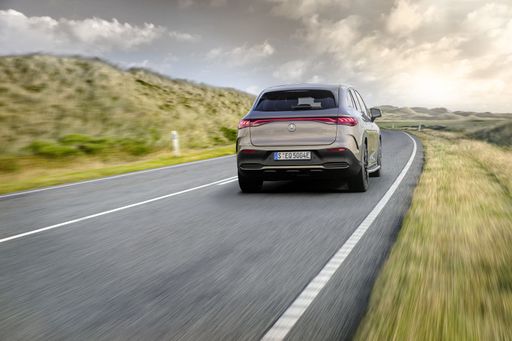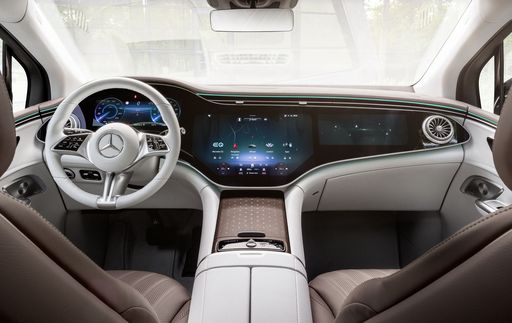Mercedes EQE SUV vs Nissan Interstar – Differences & prices compared
Compare performance, boot space, consumption and price in one view.
Find out now: which car is the better choice for you – Mercedes EQE SUV or Nissan Interstar?
The Mercedes EQE SUV (SUV) comes with a Electric engine and Automatic transmission. In comparison, the Nissan Interstar (Cargo Van) features a Diesel or Electric engine with Manuel or Automatic transmission.
When it comes to boot capacity, the Mercedes EQE SUV offers 520 L, while the Nissan Interstar provides – depending on how much space you need. If you’re looking for more power, decide whether the 625 HP of the Mercedes EQE SUV or the 170 HP of the Nissan Interstar suits your needs better.
In terms of consumption, the values are 18.30 kWh per 100 km for the Mercedes EQE SUV, and 7.40 L for the Nissan Interstar.
Price-wise, the Mercedes EQE SUV starts at 71600 £, while the Nissan Interstar is available from 34900 £. Compare all the details and find out which model fits your lifestyle best!
Mercedes EQE SUV
The Mercedes-Benz EQE SUV represents a fusion of advanced electric mobility and luxurious design, offering a refined driving experience that aligns with the brand's renowned legacy. Inside, the cabin is adorned with high-quality materials and state-of-the-art technology, providing both comfort and functionality for modern drivers. Its dynamic exterior is crafted to enhance aerodynamics while maintaining a distinctive and elegant presence on the road.
details @ group-media.mercedes-benz.com
@ group-media.mercedes-benz.com
 @ group-media.mercedes-benz.com
@ group-media.mercedes-benz.com
 @ group-media.mercedes-benz.com
@ group-media.mercedes-benz.com
 @ group-media.mercedes-benz.com
@ group-media.mercedes-benz.com
Nissan Interstar
The Nissan Interstar is a versatile van that expertly combines practicality with modern design. It offers a spacious interior that caters to both cargo and passenger needs, making it ideal for businesses and families alike. With its robust performance and efficient fuel consumption, the Interstar stands out as a reliable choice in the commercial vehicle market.
details

|
|
|
|
|
Costs and Consumption |
|
|---|---|
|
Price
71600 - 125100 £
|
Price
34900 - 55600 £
|
|
Consumption L/100km
-
|
Consumption L/100km
7.4 - 7.5 L
|
|
Consumption kWh/100km
18.3 - 23.1 kWh
|
Consumption kWh/100km
-
|
|
Electric Range
453 - 611 km
|
Electric Range
175 - 410 km
|
|
Battery Capacity
90.5 - 96 kWh
|
Battery Capacity
-
|
|
co2
0 g/km
|
co2
0 - 195 g/km
|
|
Fuel tank capacity
-
|
Fuel tank capacity
80 L
|
Dimensions and Body |
|
|---|---|
|
Body Type
SUV
|
Body Type
Cargo Van
|
|
Seats
5
|
Seats
3 - 7
|
|
Doors
4
|
Doors
4
|
|
Curb weight
2440 - 2615 kg
|
Curb weight
2053 - 2535 kg
|
|
Trunk capacity
520 L
|
Trunk capacity
-
|
|
Length
4863 - 4879 mm
|
Length
5680 - 6315 mm
|
|
Width
1940 mm
|
Width
2080 mm
|
|
Height
1672 - 1685 mm
|
Height
2498 - 2756 mm
|
|
Payload
505 - 580 kg
|
Payload
965 - 1447 kg
|
Engine and Performance |
|
|---|---|
|
Engine Type
Electric
|
Engine Type
Diesel, Electric
|
|
Transmission
Automatic
|
Transmission
Manuel, Automatic
|
|
Transmission Detail
-
|
Transmission Detail
Manual Gearbox, Automatic Gearbox, Reduction Gearbox
|
|
Drive Type
All-Wheel Drive, Rear-Wheel Drive
|
Drive Type
Front-Wheel Drive
|
|
Power HP
265 - 625 HP
|
Power HP
105 - 170 HP
|
|
Acceleration 0-100km/h
3.7 - 7.1 s
|
Acceleration 0-100km/h
-
|
|
Max Speed
210 - 240 km/h
|
Max Speed
115 - 177 km/h
|
|
Torque
550 - 950 Nm
|
Torque
300 - 380 Nm
|
|
Number of Cylinders
-
|
Number of Cylinders
4
|
|
Power kW
195 - 460 kW
|
Power kW
77 - 125 kW
|
|
Engine capacity
-
|
Engine capacity
1997 cm3
|
General |
|
|---|---|
|
Model Year
2023 - 2025
|
Model Year
2024 - 2025
|
|
CO2 Efficiency Class
A
|
CO2 Efficiency Class
G, A
|
|
Brand
Mercedes-Benz
|
Brand
Nissan
|
Mercedes EQE SUV
A New Era of Luxury: The Mercedes-Benz EQE SUV
The Mercedes-Benz EQE SUV represents a significant leap into the future of electromobility, blending avant-garde design with cutting-edge technology. As part of Mercedes-Benz's prestigious EQ line, the EQE SUV offers a perfect synergy of eco-friendly driving with the elegance and luxury the brand is known for.
Exquisite Design Meets Modern Technology
The exterior of the EQE SUV embodies Mercedes-Benz's progressive design language, maintaining SUV proportions while exuding sleekness and sophistication. Its aerodynamic silhouette, highlighted by striking LED lights and a bold grille, provides a distinctive presence on the road.
Inside, the cabin offers a luxurious atmosphere with high-quality materials and seamless integration of technology. The MBUX Hyperscreen is a standout feature, merging three screens under a single glass panel, providing occupants with an intuitive and visually impressive infotainment experience.
Impressive Performance and Range
The Mercedes-Benz EQE SUV offers a variety of powertrains tailored to different driving preferences. The electric motors provide outputs ranging from 245 to a staggering 625 PS, and the acceleration from 0-100 km/h varies from 3.7 to 7.6 seconds. Each model includes an efficient automatic transmission and either rear-wheel or all-wheel drive options.
The EQE SUV covers a generous electric range of 451 to 614 km, depending on the model, ensuring that long drives are more than achievable between charges. With energy consumption between 18.2 to 23.2 kWh/100 km, it strikes an ideal balance between power and efficiency.
Advanced Safety and Driver Assistance Features
Safety is paramount in the EQE SUV, with an array of driver assistance systems designed to ensure a secure driving experience. Features like Active Brake Assist, Attention Assist, and multiple airbags are standard, while optional extras include adaptive cruise control and lane-keeping assist for enhanced security and comfort.
Customisation and Comfort
Mercedes-Benz offers various trim levels, including AMG Line and Electric Art, each providing a different aesthetic and set of features. The EQE SUV ensures that drivers can tailor the vehicle to their personal taste with additional options like ventilated seats, panoramic sunroofs, and premium sound systems.
The EQE SUV comfortably seats five passengers and offers 520 litres of boot space, ensuring ample room for both passengers and luggage. Its dimensions maintain a sturdy presence while providing a spacious interior experience.
A Step Towards Sustainability
With zero CO2 emissions and a competitive CO2 efficiency class of A, the EQE SUV showcases Mercedes-Benz's commitment to sustainability. The use of recyclable materials and renewable energy in production further cements its ecological credentials.
Conclusion
The Mercedes-Benz EQE SUV is not just an electric SUV; it is a statement of luxury, performance, and sustainability. It encapsulates the direction in which the automotive industry is heading, all while offering exceptional comfort and cutting-edge technology. Whether it's the impressive range, innovative safety features, or the luxurious interior, the EQE SUV is a testament to Mercedes-Benz's prowess in redefining the future of driving.
Nissan Interstar
The Evolution of the Nissan Interstar
The Nissan Interstar has long been a staple in the commercial vehicle sector, known for its robust build and practical design. The latest iterations have further cemented its status with a range of technical enhancements and innovative features aimed at aiding businesses in achieving optimal efficiency. Whether you're navigating city streets or traversing the highways, the Interstar stands out as a reliable workhorse ready to meet various transport needs.
Power and Performance
The current range of Nissan Interstar models boasts diesel engines ranging from 105 to 180 PS, offering a commendable blend of power and fuel efficiency across the board. With a fuel consumption of between 7.4 and 7.5 litres per 100 kilometres, these vehicles are designed to minimise operational costs while maximizing performance.
All models feature four-cylinder engines, with engine displacement between 1997 and 2299 cm³, capable of producing torque figures between 330 and 400 Nm. These specifications ensure that the Interstar offers superior pulling power, which is particularly useful for transporting heavy loads across different terrains.
Transmission and Drive Options
Versatility is at the heart of the Nissan Interstar, with transmission options including both manual and automatic gearboxes. Drivers can also choose between front-wheel and rear-wheel drive configurations, allowing the vehicle to suit specific logistical requirements or personal preferences.
For those seeking simplicity and ease of use in urban environments, the Interstar with its automated gearshift provides a smooth driving experience, reducing driver fatigue and increasing focus on the road ahead.
Dimensions and Load Capacities
The Nissan Interstar is available in various lengths, from 5048 mm to an extensive 6848 mm, catering to diverse commercial needs. With widths ranging from 2070 mm to 2222 mm and heights from 2307 mm to 2808 mm, the Interstar offers multiple configurations to maximise cargo space and accommodate various loads.
With a maximum payload capacity of up to 1451 kg, businesses can rest assured that the Interstar is more than capable of delivering goods efficiently without compromising on safety or comfort.
Innovation and Technological Features
While functionality remains a priority, Nissan has not skimped on technological advancements. Among the innovations included are advanced safety features, such as anti-lock braking systems (ABS), electronic stability control (ESC), and a variety of sensors to assist with parking and reversing.
In terms of driver comfort, the brand offers multiple trim levels with exceptional interior features designed to enhance driver experience during long hauls. Options such as climate control, advanced navigation systems, and modern infotainment setups are available, ensuring that both driver and passenger remain comfortable and connected, regardless of the journey length.
Coachwork and Trim Options
The Interstar line-up provides a range of trim levels and equipment lines, from the entry-level Visia to the high-spec Tekna, catering to different market demands and individual preferences. The selection allows buyers to prioritise features that best suit their operation or driving style.
For example, the N-CONNECTA variant offers an array of added extras, enhancing both connectivity and comfort for drivers who rely on the vehicle as a mobile office.
Conclusion
The Nissan Interstar represents a harmonious blend of power, efficiency, and technological innovation in the large van segment. With its vast array of options and features, the Interstar is undeniably a top choice for businesses looking to invest in a dependable and adaptable commercial vehicle. As the line-up continues to evolve, the Interstar remains poised to meet the growing challenges and demands of the modern logistic landscape.
Which drive types are available for the Mercedes EQE SUV?
Available as All-Wheel Drive or Rear-Wheel Drive.
The prices and data displayed are estimates based on German list prices and may vary by country. This information is not legally binding.
